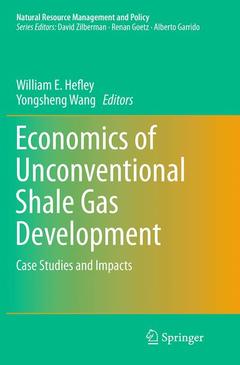Description
Economics of Unconventional Shale Gas Development, 2015
Case Studies and Impacts
Natural Resource Management and Policy Series, Vol. 45
Coordinators: Hefley William E., Wang Yongsheng
Language: English
Subjects for Economics of Unconventional Shale Gas Development:
Economics of Unconventional Shale Gas Development
Publication date: 08-2016
Support: Print on demand
Publication date: 08-2016
Support: Print on demand
Economics of Unconventional Shale Gas Development
Publication date: 12-2014
246 p. · 15.5x23.5 cm · Hardback
Publication date: 12-2014
246 p. · 15.5x23.5 cm · Hardback
Description
/li>Contents
/li>Comment
/li>
This book examines the economics and related impacts of unconventional shale gas development. While focusing on the Marcellus and Utica Shales in the Mid-Atlantic region, additional insights from other regions are included to provide a broader view of these issues. Shale gas development in recent years has changed the energy discussion in the US, as existing reserves of natural gas coupled with horizontal drilling and hydraulic fracturing make exploitation of these reserves economically feasible. The importance of natural gas is seen as likely to continue to expand over the coming years, and is expected to increase even further with environmental considerations, such as greenhouse gas emissions. Horizontal drilling and hydraulic fracturing producing natural gas from deposits such as the Marcellus Shale is making the US a net producer of natural gas. Previous studies have examined the economic impact of exploration and production in the region. Other studies have addressed legal, environmental, biodiversity, and public health impacts of unconventional shale development. This is the first volume to focus solely on the economics and related financial impacts of this development. This book not only fills the research gap, but also provides information that policy makers and the public need to better understand this pressing issue.
1. Introduction.- 2. Direct Economic Impact of the Value Chain of a Marcellus Shale Gas Well.- 3. Economic Impact Analysis on Washington County, PA.- 4. Economic Impact Analysis on Northeast PA Counties.- 5. Marcellus and the State of Pennsylvania.- 6. Marcellus and the State of West Virginia.- 7. Barnett, Eagle Ford, and the State of Texas.- 8. Communities under the Boom of Shale Gas Development.- 9. Origins and Consequences of State-level Variation in Shale Regulation: The Cases of Pennsylvania and New York.- 10. Balance between Economics and Environment: a Shale Gas Perspective.
Provides the first account of the impacts of unconventional shale gas development in the U.S. from an economic perspective
Presents a comprehensive picture using a wide range of research from multiple levels of analysis, from single wells to entire states
Contains findings in economics and policy from leaders of research and outreach in the field of shale gas research
© 2024 LAVOISIER S.A.S.




